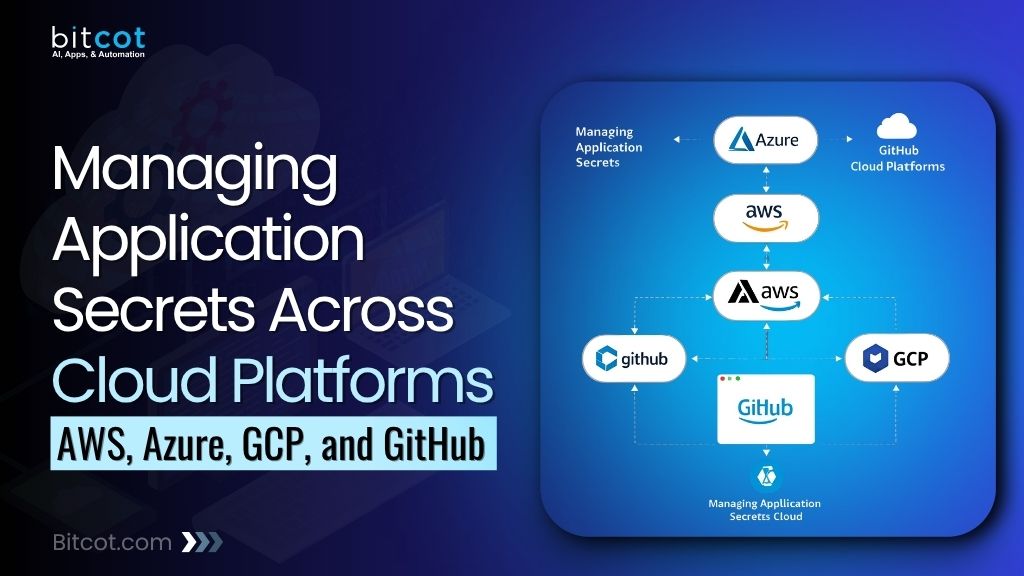
In today’s cloud-native world, secrets—such as API keys, database credentials, OAuth tokens, SSH keys, and access tokens—are critical for securely accessing systems and services. When mishandled, these secrets become major attack vectors, leading to data breaches, service disruptions, and compliance violations.
As organizations increasingly adopt multi-cloud architectures (AWS, Azure, GCP) and tools like GitHub for CI/CD workflows, the complexity of managing secrets securely across platforms becomes a major challenge. Secret management is no longer a siloed DevOps task—it’s a DevSecOps cornerstone that must span infrastructure, pipelines, and applications.
Risks & Challenges in Secret Management
Despite increased awareness, organizations continue to face real-world challenges in secret management:
Common Risks
- Hardcoded secrets in source code and configuration files
- Long-lived static credentials with no expiry or rotation
- Shared credentials across users or systems
Cross-Platform Challenges
- Disconnected secret stores across AWS, Azure, GCP, and GitHub
- Lack of unified visibility and access control
- Manual secret rotation that introduces downtime or risk
Compliance & Security Gaps
- Fragmented policies that hinder SOC 2, HIPAA, or ISO 27001 audits
- Absence of proper audit trails, versioning, and lifecycle policies
Best Practices for Secure Secret Management
Let’s explore a combination of native tools, modern innovations, and strategic policies that help you build robust and scalable secret management systems.
1. Use Native Secret Management Tools
Each cloud platform offers built-in services that should be your first line of defense:
- AWS: Secrets Manager and SSM Parameter Store
- Azure: Key Vault
- GCP: Secret Manager
- GitHub: Encrypted secrets in GitHub Actions or GitHub Codespaces
These tools support encryption-at-rest, versioning, access control, and integration with native IAM services.
2. Avoid Hardcoding Secrets in Code
Hardcoded secrets are still one of the top causes of data leaks in open-source projects.
Best Practices:
- Use environment variables or secrets injection at runtime
- Keep secrets outside of version control systems
- Scan your code using:
- GitGuardian
- Snyk
- Gitleaks
- GitGuardian
3. Dynamic Secrets with Time-Based Expiry
Instead of static credentials, issue temporary secrets with TTL:
- Use HashiCorp Vault or AWS STS for just-in-time (JIT) credentials
- CI/CD pipelines can request credentials for deployment and let them auto-expire
Reduces blast radius in case of compromise and avoids manual revocation.
4. Automate Secret Rotation
Secret rotation is essential—but must be automated to avoid errors and service outages.
Implementation:
- AWS Lambda + Secrets Manager rotation hook
- Azure Functions for syncing Key Vault
- GCP Cloud Functions to update secrets
Allows you to maintain continuous rotation and notify apps dynamically.
5. Implement Least Privilege Access
Apply RBAC (Role-Based Access Control) or ABAC (Attribute-Based Access Control) principles:
- Use fine-grained IAM roles in AWS, Azure, and GCP
- Scope secrets per project, team, or workload
- Enable logging and alerting for all secret access
6. Secrets as a Service via API Gateway
Abstract secrets behind a secure API endpoint:
- Build an internal Secrets Gateway with authentication, rate limiting, and audit logs
- Store and serve secrets from Vault, AWS Secrets Manager, or Azure Key Vault
Enables older apps or on-prem systems to access secrets securely without needing cloud SDKs.
7. Inject Secrets via Sidecar Containers in Kubernetes
For containerized apps:
- Use Vault Agent Injector, Kubernetes External Secrets, or Secrets Store CSI Driver
- Fetch secrets from external stores dynamically at runtime
Improves runtime security by avoiding secrets in Docker images or config files.
8. Zero Trust Secret Access with Identity-Aware Proxy (IAP)
In Zero Trust environments, bind access to identity and context, not IPs or firewalls.
Tools:
- Google Cloud IAP
- AWS IAM Identity Center
- Azure Conditional Access
Ensures secrets are accessed only under specific user, device, and network conditions.
9. Centralize and Standardize Secret Management
Avoid fragmented tooling. Adopt cross-platform solutions:
- Use HashiCorp Vault, Doppler, or Keyless as central platforms
- Standardize:
- Naming conventions
- Tagging policies
- Access workflows and documentation
- Naming conventions
Enables better visibility, governance, and scalability across teams and clouds.
Benefits of Effective Secret Management

Implementing these best practices delivers measurable improvements:
- Stronger security posture and reduced breach surface
- Simplified compliance with SOC 2, GDPR, HIPAA, ISO 27001
- Increased developer velocity with secure automation
- Auditable and traceable access to sensitive credentials
Final Thoughts
In a cloud-native and DevSecOps-driven world, secret management is non-negotiable. From AWS and Azure to GCP and GitHub, each environment brings its own challenges—but also native tools and strategies.
By applying modern implementations like dynamic secrets, zero trust proxies, serverless rotation, and secrets-as-a-service, organizations can achieve both security and agility.
The Definitive Checklist for Cloud Secret Management






















